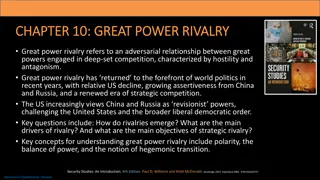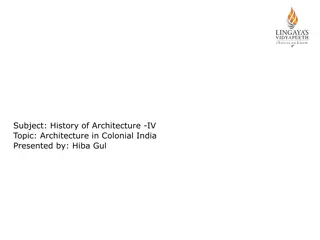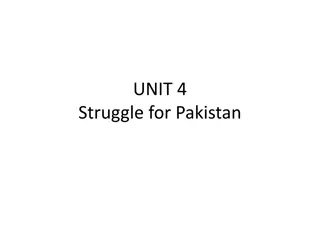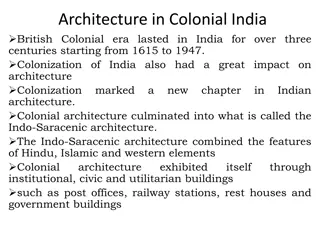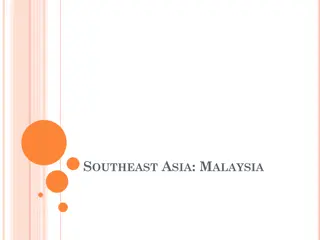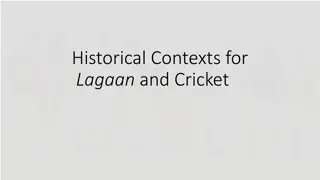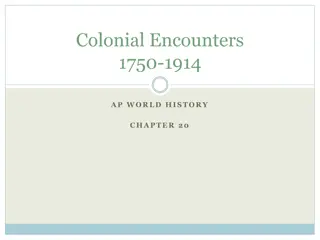European Advent in India: Colonial Rule and Trade Rivalry
Commercial contacts between India and Europe have a long history, with Europeans initially arriving as traders but eventually establishing colonies due to political and commercial rivalries. The Portuguese, Dutch, and English all played significant roles in shaping India's history through their trade activities and colonization efforts.
Download Presentation

Please find below an Image/Link to download the presentation.
The content on the website is provided AS IS for your information and personal use only. It may not be sold, licensed, or shared on other websites without obtaining consent from the author.If you encounter any issues during the download, it is possible that the publisher has removed the file from their server.
You are allowed to download the files provided on this website for personal or commercial use, subject to the condition that they are used lawfully. All files are the property of their respective owners.
The content on the website is provided AS IS for your information and personal use only. It may not be sold, licensed, or shared on other websites without obtaining consent from the author.
E N D
Presentation Transcript
Introduction The commercial contacts between India and Europe were very old via the land route either through the Oxus Valley or Syria or Egypt . But , the new sea route via the Cape of Good Hope was discovered by Vasco da Gama in 1498 . Thereafter , many trading companies came to India and established their trading centres . They entered India as traders at the outset but by the passage of time indulged in the politics of India and finally established their colonies . The commercial rivalry among the European powers led to political rivalry . Ultimately , the British succeeded in establishing their rule in India
The Portuguese The Portuguese traveller Vasco da Gams reached the port of Calicut on 17th May 1498 and he was warmly received by Zamorin , the ruler of Calicut . He returned to Portugal in the next year . Pedro Alvarez Cabral arrived in 1500 and Vasco da Gama also made a second trip in 1502. they established trading stations at Calicut , Cannanore and Cochin . The first Governor of the Portuguese in India was Francis de Almeida .later in 1509 Albuquerque was made the governor of the Portuguese territories in India . In 1510 , he captured Goa from the ruler of Bijapur . Theresfter , Goa became the capital of the Portuguese settlements in India . Albuquerque captured Malacca and Ceylon .He also built a fort at Calicut . Albuquerque died in 1515 .
The successors of Albuquerque established Portuguese settlements at Daman , Salsette and Bombay on the west coast and at Santhome near Madras and Hugli in Bengal on the east coast . However , the Portuguese power declined in India by the end of the 16th Century . They lost all their possessions in India except Goa , Diu and Daman in the next century . The Dutch The Dutch East India Company was established in 1602 .The merchants of this company came to India and established their settlements at Masulipattinam , Pulicat , Surat, Karaikal , Nagappattinam , and Kasimbazar i. In the 17th Century they won over the Portuguese and emerged the most dominent power in European trade in the East . In the middle of the 17th Century the English began to emerge as a big colonial power . The Anglo Dutch rivalry lasted for about seven decades during that period the Dutch lost their settlements to the British one by one .
The English The English East India Company was established in 1600 and the Charter was issued by Queen Elizabeth of England Captain Hawkins arrived at the royal court of Jahangir in 1609 to seek permission to establish English trading centre at Surat . But it was refused by the Mughal Emperor due to Portuguese Pressure . Later in 1612 , Jahangir issued a farman (permission letter ) to the English and they established a trading factory at Surat in 1613 . Sir Thomas Roe came to India as ambassador of James I , the King of England to the Mughal court in 1615 . He obtained permission from Jahangir to establish English trading factories in different parts of India .
The English established their factories at Agra , Ahmadabad and Baroda by 1619 . The East India Company acquired Bombay from Charles II , the then king of England . In 1639 , Francis Day founded the city of Madras where the Fort St. George was built . in 1690 , an English factory was established at Calcutta where Fort William was built .later Calcutta became the capital of British India . Thus Bombay , Madras , Calcutta became the presidencies of the English settlements in India . The French The French East India Company was formed in 1664 by Colbert , a Minister under Louis XIV. The first French factory in India was established at Surat by Francis Caron. Later , Maracara set up a factory at Masulipattinam . Francois Martin founded Pondicherry in 1673 .
Other French factories in India were Chandranagore , Mahe and Karaikal . Francois Martin was the first governor of Pondicherry , the headquarters of the French possessions in India . The Danes Denmark also established trade settlements in India . Their settlement at Tranquebar was founded in 1620 . Another important Danish settlement in India was Serampore in Bengal . Serampore was their headquarters in India . They failed to strengthen themselves in India and they sold all their settlements in India to the British in 1845 .
Anglo French Rivalry In the beginning of the 18th century , the English and the French were competing with each other to establish their supremacy in India . The Anglo French rivalry in India was manifest in the Carnatic region and in Bengal . The Carnatic Wars . The downfall of the Mughal Empire led to the independence of Deccan under Nizam ul Mulk . The Carnatic region also formed part of the Nizam s domination. In 1740 , the Austrian War of Succession broke out in Europe . In that war England and France were in the opposite camps. They came into conflict in India also .
The French governor of Pondicherry , Dupleix opened attack on the English in 1746 and thus began the First Carnatic War ( 1746 1748 ). The English sought help from the Nawab of Carnatic , Anwar ud din . But French concluded a treaty with his rival Chanda Sahib . The English army crushed a defeat on the French in the Battle of Adyar , near Madras . In the meantime , the Treaty of Aix- la- Chappelle was concluded in 1748 to end the Austrian Succession War . Thus the First Carnatic War came to an end .
But the English and French continued to take opposite sides in the internal politics of India . As a result , the Second Carnatic War ( 1749 1754 ) . Dupleix supported the cause of Muzafar Jang, who wanted to became the Nizam of Hyderabad Chanda Sahib wanted to became the Nawab of Arcot . The troops of these three defeated Anwar ud din , who was with the British in the First Carnatic War , and killed him in the Battle of Ambur im1749 . After this victory , Muzafar Jung became the Nizam and Chanda Sahib became the Nawab of Arcot . Muhammad Ali , son of Anwar ud din escaped to Tiruchirappalli . The English sent troops in support of him . In the meantime , the British commander Robert Clive captured Arcot .
Robert Clive defeated French at Kaverippakkam . Chanda Sahib was captured and beheaded in Tanjore . Meanwhile Dupleix was replaced by Godeheu as the French governor . The war came to an end by the Treaty of Pondicherry in 1754 . The outbreak of the Seven Years War ( 1756 1763) in Europe led to the Third Carnatic War ( 1758 1763 ) . Count de Lally was the commander the French troops . The British General Sir Eyre Coote defeated him at Wandiwash in 1760 . In the next year , Pondicherry was captured and destroyed by the British troops . The Seven Years War came to an end by the treaty of Paris in 1763 . The Third Carnatic War also ended .
The French agreed to confine its activities in Pondicherry , Karaikkal , Mahe and Yenam . Thus the Anglo French rivalry came to a close with British success and French failure . Causes for the French failure . 1. Commercial and naval supremacy of the English only in the Deccan but the English . 2. Lack of support from the French Government . 3. The French had support only in the Deccan but the English had a strong base in Bengal . 4. English had three important ports Calcutta , Bombay and Madras but French had only Pondicherry . 5. Difference of opinion between the French Generals . 6. England s victory in the European wars decided the destiny of the French in India
India under the East India Company The English East India Company was established on 31st December 1600 as per the Royal Charter issued by the Queen of England , Elizabeth I . After the Battle of Plassey in 1757 and the Battle of Buxar in 1764 , the Company became a political power . India was under the East India Company s rule till 1858 when it came under the direct administration of the British Crown . Robert Clive was the first Governor of Fort William under the Company s rule . He was succeeded by Verelst and Cartier . In 1772 , the Company appointed Warren Hastings as the Governor of Fort William .
Warren Hastings He assumed the administration of Bengal in 1772 , he found it lot of chaos . The financial position of the Company became worse and the difficulties were occurred by famine . Therefore , Warren Hastings realized the immediate need for introducing reforms . Abolition of Dual System The East India Company decided to act as Diwan and to undertake the collection of revenue by its own agents . Hence , the Dual System introduced by Robert Clive was abolished .in order to improve the finances of the Company , Warren Hastings reduced the Nawab s allowance of 32 Lakhs of rupees to half that amount . He also stopped the annual payment of 26 Lakhs given to the Mughal Emperor .
Revenue Reforms After the abolition of the Dual System , the responsibility of collecting the revenue fell on the shoulders of the Company . For that purpose , a Board of Revenue was established at Calcutta to supervise the collection of revenue . English collectors were appointed in each district . The Treasury was removed from Murshidabad to Calcutta and an Accountant General was appointed . Calcutta became the capital of Bengal in 1772 and shortly after of British India .
The Board of Revenue farmed out the lands by auction for a period of five years . The Zamindars were given priority in the auction . However , certain good measures were taken to safeguard the interests of the peasants . Arbitrary cesses and unreasonable fines were abolished . Besides , restrictions were imposed on nthe enhancement of rent , Yet , the system was a failure . Many Zamindars defaulted and the arrears of revenue accumulated . Reorganisation of the Judicial System : The Judicial system during his period was a store house of abuses . The Nawab who hitherto the chief administrator of Justice , misused his powers . Often , his judgements were careless . The Zamindars who acted as judges at lower levels within their own areas were highly corrupt and prejudiced .
On the whole , the judicial institution suffered from extreme corruption . He felt that the necessity of reorganising the judicial system . Each district was provided with a civil court under the Collector and a Criminal court under an Indian Judge . To hear appeals from the district courts to two appellate courts , one for civil cases and another for criminal cases , were established at Calcutta . The the highest civil court of appeal was Sadar Diwani Adalat which was to be presided over by the Governor and two Judges recruited from the members of his council. The highest appellate criminal court was known as Sadar Nizamat Adalat under an Indian Judge appointed by the Governor in council . Experts in Hindu and Muslim laws were provided to assist the Judges .
The Hindu law was prepared in Sanskrit by learned Pandits and it was translated into Persian . An English translation of it Code of Hindu Laws was prepared by Halhed . Other Reforms :


